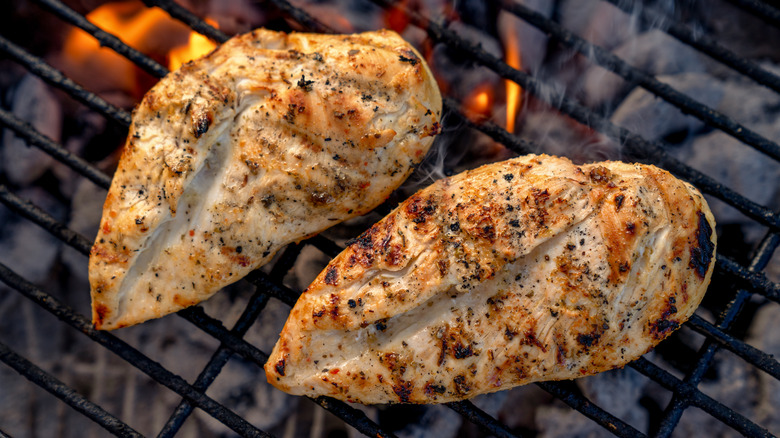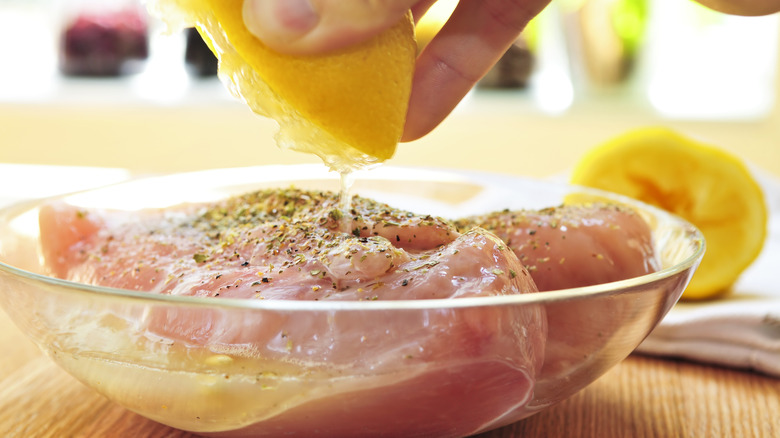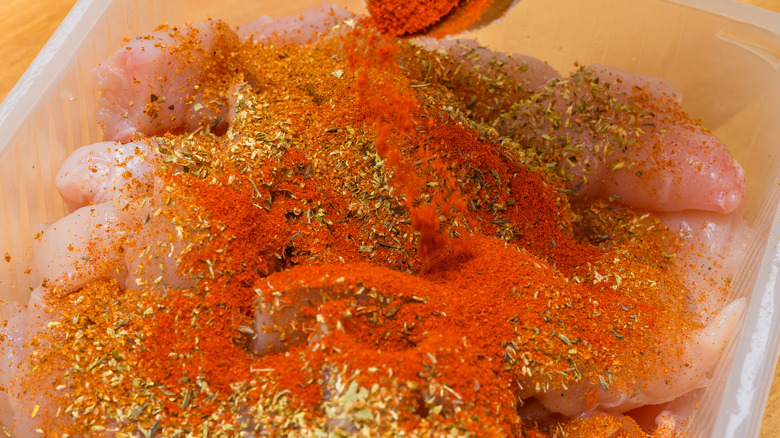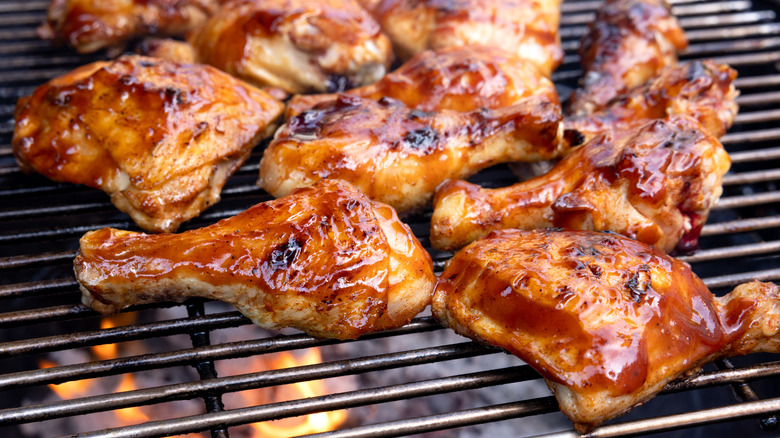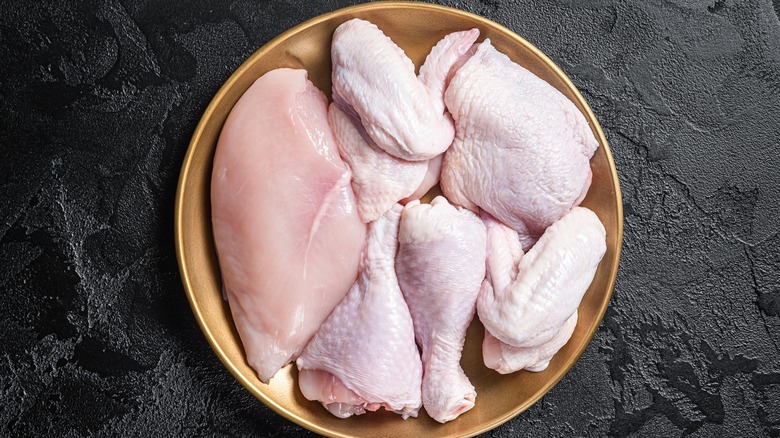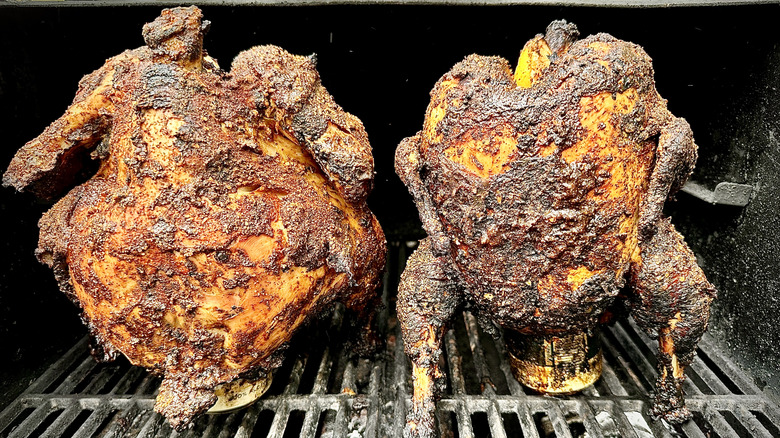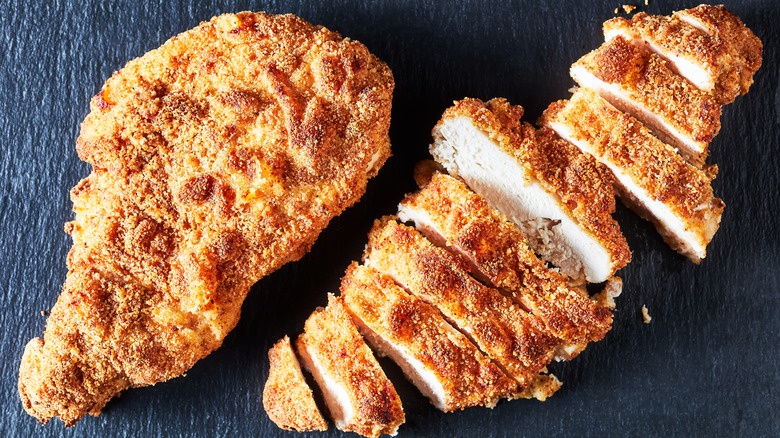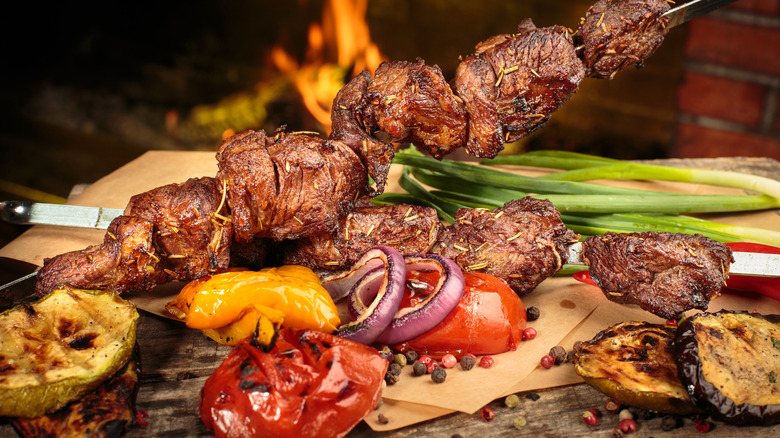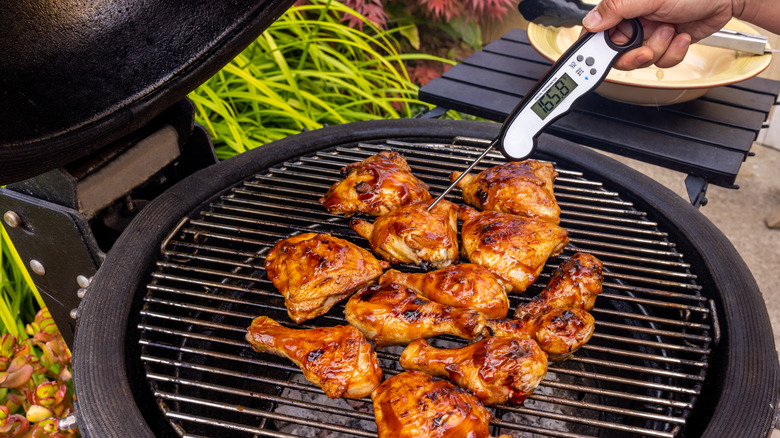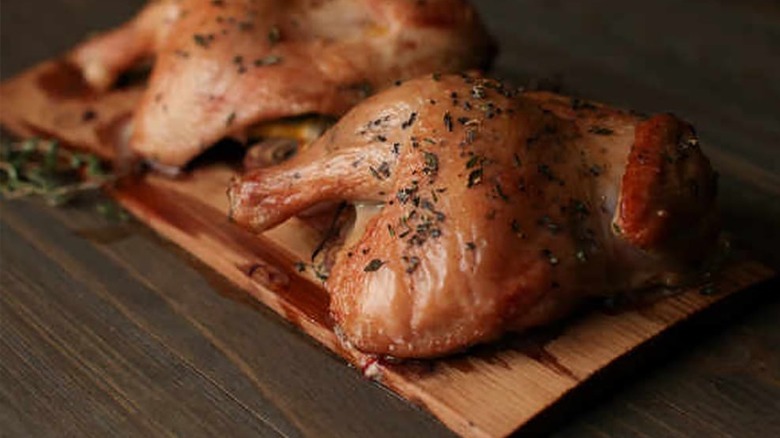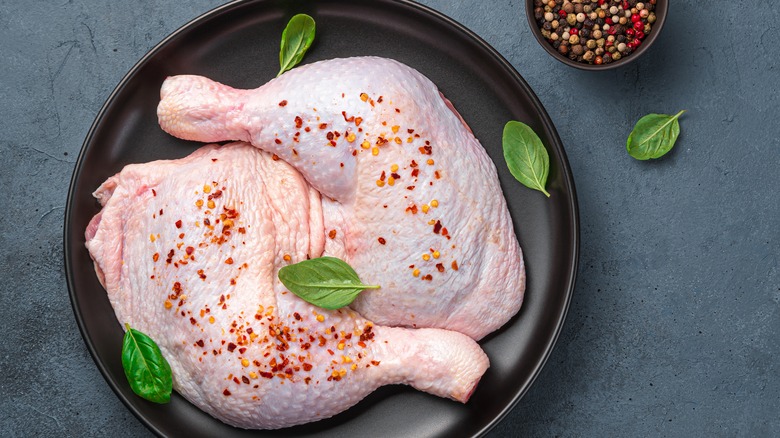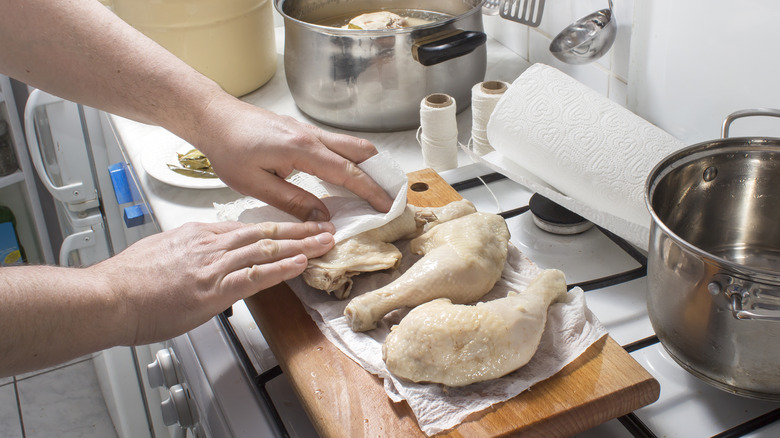12 Tips For Adding More Flavor To Grilled Chicken
When the sun's shining, it's time to break out those grill tongs. Chicken is a popular choice for grilling because it can take on so much flavor and is adaptable to just about any type of cuisine. Chicken works well on its own or as part of a larger spread, salad, or dish. Some of the best ways to enjoy chicken include grilling or smoking with your favorite spice blend, dry rub, or sauce.
Consider the cut, added spice and seasonings, flavor, and cooking technique to get the most out of a delectable piece of chicken. Prep work like marinating adds flavor that takes center stage when it finally reaches the plate. Dry rubs and sauces also keep chicken moist and tender. Because it has a lower fat content than some other types of meat like beef or pork, chicken can get dry if overcooked. Boosting the moisture in the bird will help flavor and texture.
Other techniques, such as smoking, require more time to cook but impart unique and complex flavors to the meat. You can also choose your cuts carefully at the store to make the most of your flavor boosters and your budget. Whether you go with large, bone-in pieces or smaller, portable kabobs, chicken has a place in every summer grill lineup.
1. Marinate chicken before cooking
Before grilling, whip up a homemade marinade or opt for a premade one. The secret to a great marinade is balancing acid, fat, and flavor. The acid, usually from wine, juice, or vinegar, tenderizes the meat, helps it stay moist, and makes it absorb more flavor. Fat from oils helps all of the ingredients blend and also keeps the meat from drying out. Marinades come in combinations that work with almost any kind of cuisine. You can opt for chicken street tacos with a smoky adobado marinade or choose something with plenty of herbs and garlic, such as a Greek chicken grain bowl.
When marinating, it's best to let your meat sit for at least a few hours to absorb maximum flavor. Better yet, make it the night before and let the chicken marinate overnight before grilling. For food safety, store the chicken in the fridge while it marinates. Chicken should be kept at a temperature below 40 F to prevent salmonella bacteria from growing. Once you have the chicken in the fridge marinating, cook and eat it within two days. Throw away any excess marinade to reduce the risk of foodborne illnesses.
2. Brine your chicken overnight
Since high-heat cooking can dry chicken out quickly, soaking it in a brine ahead of time will ensure that you always end up with the perfect cutlet. To make a simple wet brine, add salt to hot water. Make sure that the salt is dissolved in the water. It's important to pay attention to the saltiness of the water and the type of salt that you use. Larger salt crystals require more salt in the water, typically between 4 and 6 tablespoons for 4 cups of water. Fine, table salt only needs around 3 tablespoons for the same amount of water. You can also choose a dry brine method. Using this technique, rub your chicken breast with salt and store it in the refrigerator.
The main benefit of brining is to make your chicken extra moist and tender. The salt makes the water more easily absorbed by the meat. Salt also helps break down the chicken's proteins, resulting in a more tender bird. Chicken tends to be very lean compared to other types of meat. This means that it can be dry, which is why brining is such an important step to take before you start cooking. Salt also acts as seasoning, imparting a more intense flavor to the final dish. You can add sugar and dried herbs to make the brine do double duty and boost the flavor even more.
3. Use a spice rub before grilling
Add a dry rub to the exterior of your chicken before grilling. This technique brings flavor but also helps create a seared crust on the exterior of the meat. It's best to apply it liberally to the exterior of the bird at least an hour before grilling. Like marinade, the longer you let it sit on the meat, the more flavorful it will eventually be. Make sure to wash your hands thoroughly after applying to reduce the chance of salmonella bacteria contamination. You don't need to rinse off the rub before grilling. Just put the chicken directly onto a high-heat grill to let the flavors work their magic.
You don't need a lot of ingredients to make a delectable dry rub. This simple 3-ingredient dry rub recipe only calls for garlic salt, brown sugar, and smoked paprika. It combines salty, sweet, and spicy flavors all in one easy-to-apply rub. You can customize the proportions to suit your preferences. Store-bought dry rubs are also easy to use, although they don't offer as much customization. You can use most dry rubs on a variety of meats. Even grilled vegetables get a flavor kick when a dry rub is applied. To make meal prep even easier, make a large batch to keep in the pantry. Dry rubs are shelf-stable and can last for months.
4. Add sauce while grilling
While grilling, you can baste the meat with sauce using a brush to create a delicious coating that is full of flavor. A higher sugar content will mean more caramelization. It can also mean faster cooking and increased potential for burning. If you have a sauce with a lot of sugar, wait until a bit later in the cooking process to add it. Make sure to use a meat thermometer to measure the internal temperature of your chicken. Sauce tends to cook faster than chicken, making it difficult to gauge the actual doneness of your bird.
Barbecue or buffalo sauce are popular choices but you can go with almost any sauce to work with chicken. Sauces with sugar, brown sugar, honey, or maple syrup work well because they create a nice crust on the outside of the meat. You can make your own sauce or use a store-bought variety. Apply the sauce during the last 5 minutes of cooking for great results. If you want more sauce, keep some to the side to serve alongside your dish. Also known as dipping sauce, these work great with chicken, grilled vegetables, and even as a condiment for fries. Drip pans and shelf mats help to keep the cooking area tidy and make clean-up easier.
5. Consider bone-in chicken
While boneless cuts are convenient, using a bone-in leg or thigh is a great choice for grilling. The bone keeps the inside of the meat moist during the cooking process thanks to the fat inside the bone. During grilling, it melts and makes its way into the meat. Whether you are grilling, roasting, or frying chicken, bone-in cuts like thighs and wings almost always result in moist, tender meat. If you still prefer not to deal with the bone while enjoying your meal, you can carve the meat before serving. For thrifty chefs, saving the bones to make chicken broth means more use in the future.
Bone-in chicken works well with other cooking techniques to add flavor, such as marinades and dry rubs, as well. If you are cooking for a crowd, you might even want to grill an entire chicken. The bone inside the bird adds fat and flavor to all of the meat. It also makes the cooking time and process very efficient. Look for a stand to keep the bird upright or use a can of liquid with spices to hold the bird in place, adding even more flavor. Just be ready to closely monitor the cooking time and internal temperature of the bird. Bone-in chicken cooks slower than boneless cuts but varies depending on the size of the bird.
6. Smoke chicken in the grill
Smoking wood in the grill adds an entirely new depth of flavor. This technique works well at low temperatures, typically between 225 and 250 F. This means longer, more controlled cooking. You can use a traditional charcoal grill or a smoker. Either way, it's important to be aware of your grill's temperature to ensure you don't overcook the meat. A drip pan with an inch of water is the perfect way to keep the inside of your grill moist during the entire smoking process. As the chicken cooks, the water heats and evaporates, keeping the interior of the grill moist and the chicken tender.
Each type of wood has a subtly different profile. Oak tends to have a heavier flavor and works well with a variety of meats, making it a good choice for beginners. It also burns evenly, resulting in more consistent results. Hickory can be a bit stronger and maple has a slightly sweeter flavor. Both work well with chicken but create very different results. You can find wood pellets designed for use in a smoker or grill to make the process easy and foolproof. Many often come with recommended sauce or spice pairings to make the most of the flavors.
7. Create a breadcrumb coating
Adding a breadcrumb coating to the chicken creates a crispy crust with plenty of flavor. If you love the crispiness of fried chicken but are trying to keep your fat intake down, grilling is a fantastic alternative. To bread your chicken, simply coat it in flour, dip it in raw egg, and add the breadcrumb coat. This method is called dredging. Coating the chicken in flour and egg before adding the bread crumbs helps them adhere better. If you find that your breadcrumbs aren't sticking to the chicken, adding a bit of cornstarch to the mixture can make all the difference. This method works well for any cut of chicken as well as tenders or kabobs.
You can customize it with a spice blend for added flavor and texture. Dried spices added directly to your breadcrumb mixture is the easiest way to customize the dish. You can also include shredded cheese, mayonnaise, mustard, or hot sauce for some extra kick. Some chefs even get creative with the crumbs themselves, grinding up everything from cornflakes to potato chips for something truly unique. If you are making your own breadcrumbs, make sure that they are dry and easy to crumble. Store-bought crumbs, which can come pre-seasoned, make the process a bit simpler.
8. Grill chicken and vegetable kebabs
Grill chicken alongside vegetables and fruits for a tasty all-in-one meal. The prep work for all parts of the kebabs is similar, although you should always be careful when handling raw chicken. When grilling, make sure to go by the chicken's internal temperature to determine when the entire kebab is done. Vegetables and fruits can take a bit of extra grilling and caramelize as they cook. Undercooked chicken, however, can cause foodborne illnesses like salmonella poisoning. One of the best cooking tips for perfect kebabs is to cut the chicken, vegetables, and fruits in similar sizes. Soak skewers overnight ahead of time to prevent them from burning.
You can use a marinade, rub, or sauce on chicken kebabs just like on other cuts of meat. Some recipes are inspired by traditional regional cuisine, such as these chicken, pepper, and onion kebabs that get their flavor from saffron and yogurt just like the traditional Persian dish jūjeh-kabāb. Other varieties use Middle Eastern spices including thyme, oregano, sesame seeds, and sumac, such as these za'atar chicken skewers. Kebabs and skewers are easy handheld dishes and also pair well with flatbreads such as lavash or pita. You can serve them with dipping sauces or on their own since the fruits and vegetables retain quite a bit of their water content even after grilling.
9. Test doneness with a meat thermometer
One of the difficulties of grilling chicken is avoiding overcooking. Compared to other meats, such as beef or pork, chicken is lean and doesn't have a lot of fat in most cases. This means that it tends to dry out when it grills, especially over high heat. Using a meat thermometer will ensure that you don't overcook and end up with dry, tough pieces of chicken. Another risk when grilling chicken is to end up with underdone chicken that is still raw inside. Even though the exterior might be crispy and delicious, if the interior isn't cooked through, harmful bacteria like salmonella can make you sick. The internal temperature of the chicken should be 165 F. A meat thermometer allows you to monitor and check the temperature to make sure that your chicken is done before you take it off the grill.
Simply stick the thermometer into the meatiest part of the chicken while still on the grill and read the temperature. Some models have markings for temperature based on the type of meat. If you are smoking chicken or other meats, it might be better to leave the grill closed during cooking. In this case, you can set up a thermometer that you can read without lifting the lid. This lets you keep track of the internal temperature of your food without constantly letting the heat out.
10. Cook it on a cedar plank
Just like with smoking, grilling with wood planks imparts a unique extra flavor to your chicken. Cedar works for a variety of dishes, including chicken, pork, and fish. You can even add vegetables and fruits alongside your meat. Grill chicken directly on a cedar plank for a unique sweet and smoky flavor, and cook it over indirect heat for the best results. Keep in mind that the chicken likely won't get as much of a char as it would when cooked directly over the flame. But the added flavor from the cedar can make this a truly delectable way to grill chicken. You can also add marinade, dry rub, or other spices to create a unique flavor profile in your dish.
Planks also help the chicken stay juicy because they keep it moist throughout the cooking process. Cedar has moisture inside the wood, which is absorbed into the chicken. Before using, soak the cedar plank in water for a few hours. This will keep it from becoming too dry and potentially catching fire over the grill's flame. You can reuse your cedar planks but the flavor from the wood will lessen with each use. The strongest flavor comes from the first use. It's also important to clean cedar planks properly with hot water without soap, especially if you want to reuse them. Make sure to keep designated cedar planks for chicken, pork, and fish, and do not mix them.
11. Opt for dark meat
Cuts of dark meat, such as drumsticks or thighs, tend to be juicier and have a richer flavor compared to white meat. This is due to a higher fat content, which many people find more flavorful. This higher fat content works well with marinades and sauces to create grilled chicken that is moist, tender, and full of flavor. It also helps them stay moist on the grill. Dark meat chicken cuts, especially thighs, can have irregular thickness compared to the popular chicken breast cut. Drumsticks are thick but taper on one end. Make sure to pay close attention to the internal temperature of the meat to prevent overcooking. Fortunately, dark meat can take a bit more heat than white meat without drying out. Always measure the internal temperature at the thickest point of the chicken to ensure that it is done and safe to eat.
Dark meat cuts like thighs, legs, and drumsticks can be found in whole pieces or quarters. They also come with and without the bone. Dark meat is also generally cheaper, and because it stays moist, it's less likely to need brining or other prep steps. You can put dark meat chicken right on the grill with some salt and pepper and trust that it will turn out tasty. Of course, adding marinade, sauce, or other seasonings to your grilling process can make the flavor even better.
12. Pat chicken dry before grilling
One surefire way to get a crispy, delicious exterior is to put dry chicken on the grill. Fortunately, this method only requires a simple extra step before grilling. Just pat the exterior of the chicken dry with a paper towel. Removing any excess moisture means that the chicken skin will be crackled and charred after grilling. Make sure to dispose of the paper towel afterward and wash your hands thoroughly to prevent contamination with any other food that you are preparing. Add salt, pepper, or other seasonings to make the flavor even more intense. Then cook the chicken over a high-heat grill and enjoy extra crispy chicken.
If you want to go a step further, pat the chicken dry and then let it rest in the refrigerator overnight. The refrigerator's cold air removes even more moisture, and a dry brine of salt will draw out moisture from the skin. Just be careful not to overdo it, because you want to keep the interior of the chicken moist and tender. Adding sauce or marinade boosts flavor but doesn't create a crispy skin on its own. Instead, sauce with a high sugar content caramelizes to create its own crispy coating. While a different method, caramelized sauce coating is a good option for those who like a crispy exterior but want a bit more flavor than what the chicken comes with on its own.
